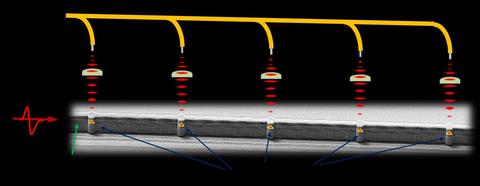Quantum Light Sources
The Technology

Over the next decade, there will be an explosion of progress in circuits and networks for quantum information processing. Many key emerging technologies such as those used for unbreakable encryption or simulations of complicated processes will demand efficient and reliable sources of on-demand single and indistinguishable photons.
To meet that need, NIST researchers are developing integrated photonic chip sources utilizing semiconductor quantum dots (QD, in effect solid-state artificial atoms) coupled with optical cavities to produce “bright” single photons — that is, those with a high probability of being detected — on demand.
The design also incorporates on-chip, reference-free verification of the source’s quantum properties — a self-test to confirm that the device is operating correctly and that accuracy is within specifications.
The chip contains a series of QD/cavity single-photon light sources with dimensions in the few-nanometer range, each of which produces no more than one photon within a clock cycle defined by the power source. The QDs are created in single-crystal growth of InAs and embedded in single-crystal GaAs containing the cavities. The system operates at around 4 K.
Each QD, created in the crystal growth process, is excited by the power source and emits single photons that couple via waveguides that have a series of embedded microcavities. The cavity dimensions, about 2 µm in diameter, are modified using nanofabrication techniques common in the semiconductor industry so that they only couple to light emission at a narrow band wavelength — the QD single photon wavelength. The resulting bright photons are routed off-chip for the user’s purposes.
Advantages Over Existing Methods
More common single-photon sources typically produce a random single photon output, i.e., not on demand, and are not bright enough for optimal use in the next generation of advanced technologies. QD/cavity chips meet those needs and do so in a robust semiconductor chip format that can be scaled easily. And although some companies are developing such sources, at present they require substantial expertise in semiconductor crystal growth and processing, or partnership with a group that has that knowledge.
The NIST single-photon source, by contrast, is intended to be a fully turnkey operation. Mature versions, with integrated on-chip power and output verification, can be delivered to a variety of end users with little or no experience in quantum optics or semiconductor physics.
They will also include two important features. The first is a waveguide that couples several cavities together so that they can share a common power source and have synchronized emissions. Eventually this power source will be integrated directly on the chip.
The second feature will be an on-board diagnostics circuit that checks to make sure the source or sources of single-photon light are in fact making no more than single photons. In mature versions the detectors for this diagnostics circuit will also be mounted on the chip.
Device development has benefited directly from parallel NIST research projects. One is investigating single-photon detectors that will have uncertainty of less than 1%. Another is fabricating the kind of quantum photonic circuits and waveguides that will be needed to connect components on the single-photon light source chip.
Applications
The market for bright single-photon sources is expected to grow, as they will be employed in a variety of emerging technologies including the quantum candela (metrology), microscopy (using quantum light for better resolution), quantum computing and simulation, and networking. The last two will be essential to solving certain kinds of problems that are intractable using conventional electronics. These include breaking encryption codes, finding optimal solutions to problems with hundreds of separate variables, and searching enormous databases.
Key Papers
T. Huber, M. Davanco, M. Müller, Y. Shuai, O. Gazzano and G.S. Solomon. Filter-free single-photon quantum dot resonance fluorescence in an integrated cavity-waveguide device. Optica. April 24, 2020. DOI: 10.1364/OPTICA.382273
T. Thomay, S.V. Polyakov, O. Gazzano, E. Goldschmidt, Z.D. Eldredge, T. Huber, V. Loo and G.S. Solomon. Simultaneous, full characterization of a single-photon state. Physical Review. Nov. 15, 2017. DOI: 10.1103/PhysRevX.7.041036

